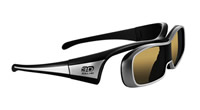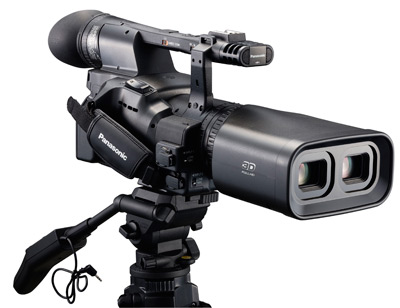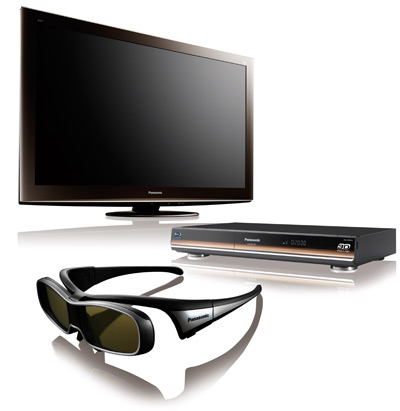|
|
||||
Still, the Panasonic equipment does look great and their 3D demos were pretty cool, though I tend to reserve final judgment until I've actually experienced such things operating in my own environment. Not that I don't trust them, mind you, but I'm a bit of a curmudgeon that way.
Anyway, they fired up a selection of their 3D full HD VIERA plasma product line and, naturally, they got their picture via Panasonic 3D Blu-ray players, the higher end of which even offers 7.1 analog audio output, a very nice touch for snobs like me.
We got to see some "nature" demo footage that included a pretty cool trip down the Grand Canyon's Colorado river in a Zodiac, with water splashing up onto the camera and, therefore, nearly into our eyes. That part was definitely cool, and the 1080p picture looked great, as sharp and clean and compelling as the best plasmas can be.
It still requires glasses to watch the 3D effect, and that's a pain in the rump. Rumors abound about "glassesless" 3D, and I think that'll be a requirement for 3D to become more than just an interesting niche, but it's going to be tough to pull it off. Panasonic's Active Shutter glasses, which are sold separately and run about $150 U.S. a pop, are very cool and quite comfortable (though I only had them on for a few moments at a time), and are an integral part of the process. The shutters block off one eye at a time, helping ensure that each eye gets only the appropriate image.
Panasonic says the 3D glasses can also be worn comfortably right over ordinary prescription glasses.
The system works well, far better than the silly red and blue glasses-type of 3D that's been around forever, including on some Blu-rays. Those discs display both images simultaneously and use the colored filters to separate them, but it leaves a lot of errant color fringing and is tough on the eyes, though the 3D itself isn't bad.
 One thing you should be aware of about 3D is that, rather than the extra dimension meaning things are going to jump out of the screen at you, it works more as if the surface of the TV screen is a window you're looking through onto a 3D world beyond it. This means most of the dimensionality stretches away from you, rather than coming into the viewing room with you.
One thing you should be aware of about 3D is that, rather than the extra dimension meaning things are going to jump out of the screen at you, it works more as if the surface of the TV screen is a window you're looking through onto a 3D world beyond it. This means most of the dimensionality stretches away from you, rather than coming into the viewing room with you.
That doesn't mean it can't be cool, but don't expect to be ducking every few seconds. Such effects can be done, but mostly (at least as I've seen in my limited demo time) it's a more passive situation where you're a peeping Tom looking into a 3D world a few feet away from you. Not that there's anything wrong with that.
I'd have to see a lot more 3D to be convinced of its value, but even if it doesn't catch on Panasonic offers a pretty good reason to buy a 3D TV anyway: they're the best of the best whether you're watching 2D or 3D.
To stress this point, Barry Murray, Director of Marketing, Panasonic A/V Group, says "Unless it’s a special movie or sporting event like World Cup, most of us will still watch our favorite television programs and films in 2D. Most people are surprised to learn that with a simple touch of a button, Panasonic's 3D models convert effortlessly to 2D for the best picture and easy viewing preference."
And that may be 3D's ace in the hole.
Panasonic only offers its 3D wares in its plasma line, the rationale being that, all things considered, plasmas are overall better performers than LCD, with faster refresh, better contrast and a generally richer picture.
"When all is said and done," Murray says, "Consumers are most interested in great picture quality and Panasonic is totally committed to the success and growth of Plasma as the best technological solution for a home theatre.”
 The rationale is that LCD's are great for places where you may not be as concerned about optimal picture quality as you are, at least theoretically, in the home theater. I can dig it. I have a 37 inch, 720p LCD in my living room where it's more than adequate for what I watch there – mostly non-HD satellite TV with the occasional DVD thrown in.
The rationale is that LCD's are great for places where you may not be as concerned about optimal picture quality as you are, at least theoretically, in the home theater. I can dig it. I have a 37 inch, 720p LCD in my living room where it's more than adequate for what I watch there – mostly non-HD satellite TV with the occasional DVD thrown in.
I opted for a plasma in my "small" home theatre and am glad I did; it looks fabulous. My "big" home theater does feature an LCD, but it's a front projector, throwing its image onto a 106 inch screen. The rationale? Plasmas aren't suitable as projectors and to get that screen size in a plasma would cost more than my dear wife would allow me to spend in this lifetime.
But ask me again in 10 years!
Anyway, I agree with Panasonic's rationale about plasma vs. LCD, and it fits in with their rationale about 3D: it's meant more for high end home theater applications than for casual viewing. This makes sense, if only because the glasses (as high tech and nifty as they may be) are a pain in the butt and I don't think I'd want to be wearing them for everything I watch.
At least they're wireless!
That "high end" aspect to Panasonic's 3D TV's means they not only sport the company's best picture technology, but they also bristle with features like the USB-based VIERA CAST which, once you add a wireless LAN adaptor (and perhaps a keyboard and USB memory) lets you surf sites such as YouTube, Picasa Web Album, Bloomberg, Twitter, a weather service and even Skype3.
Panasonic has also introduced a nifty gadget you can use to give your home movies a nice 3D effect when you shoot them. I saw a demo of a Panasonic guy's toddler daughter and the 3D worked quite well, though it made me curious to see how a baby spitting up would come across in 3D.
In the grand scheme of things, it probably doesn't matter if 3D takes off. The electronics manufacturers are making the technology available on their higher end sets anyway, so even if you don't watch something in 3D you're still getting the best TV a particular company can make.
Right now 3D prices are higher than their 2D counterparts and that will probably never change, but prices always come down and so today's expensive 3D set will soon sell for the price of today's expensive 2D set, while 2D prices will continue to drop as well.
If 3D does take off, 2D sets may go the way of the dinosaur, but since the 3D technology is backwards compatible your existing library of movies on DVD and Blu-ray will play on them anyway, so upgrading to a 3D TV or other device may not be a big deal in the long run.
Copyright 2010 Jim Bray
TechnoFile.com
Jim Bray's columns are available through the TechnoFile Syndicate.

 Panasonic Betting Big Time on 3D TV
Panasonic Betting Big Time on 3D TV